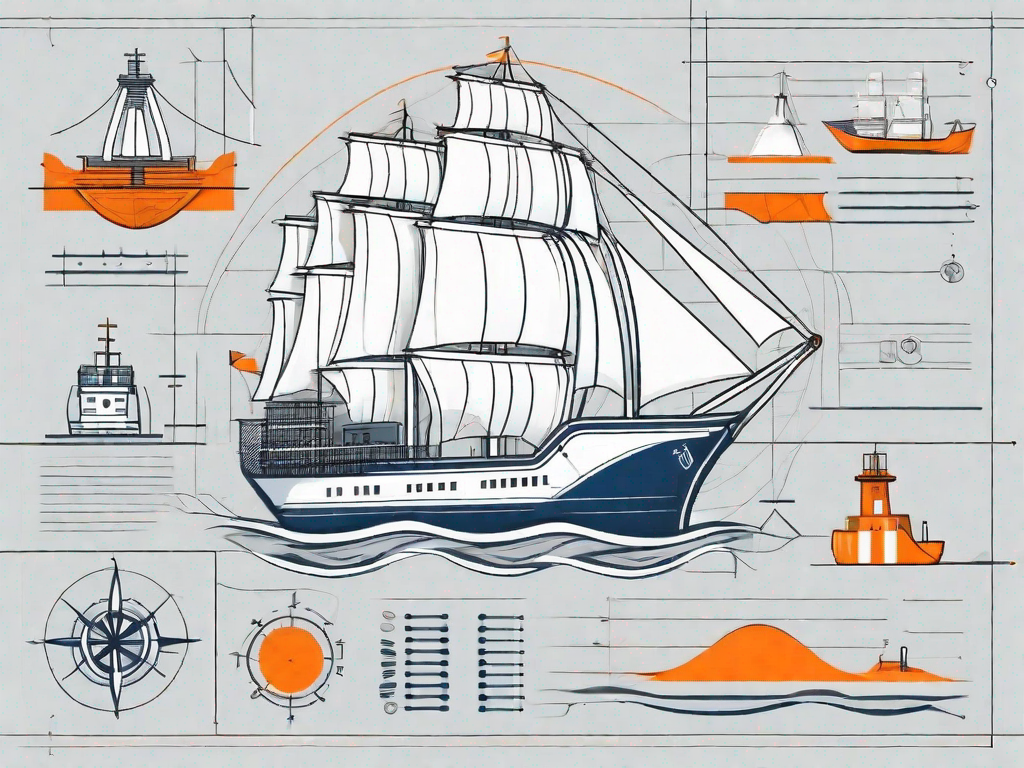.svg)
Creating a Design Strategy Template for Marine and Shipping
.svg)

When it comes to the marine and shipping industry, having a well-defined design strategy is crucial for success. A design strategy serves as a roadmap for creating effective and impactful designs that meet the unique needs and challenges of this industry. In this article, we will explore the importance of a design strategy in marine and shipping, the essential elements of a design strategy template, and the steps to create and implement one.
Understanding the Importance of a Design Strategy in Marine and Shipping
The maritime industry operates in a highly competitive and dynamic environment. A well-crafted design strategy helps companies in this sector to navigate through the challenges and stand out in the market. It serves as a guide to align design decisions with business objectives, enhance user experience, and create a strong brand identity.
When it comes to the marine and shipping industry, the significance of a design strategy cannot be overstated. This industry is not only responsible for transporting goods across the globe but also plays a crucial role in international trade and economic growth. A well-thought-out design strategy enables companies to develop vessels and systems that are not only efficient but also environmentally friendly, helping to reduce the industry's carbon footprint.
The Role of Design Strategy in the Maritime Industry
In the maritime industry, where safety and efficiency are paramount, design strategy plays a vital role. It helps companies develop innovative solutions that optimize operations, improve vessel performance, and reduce environmental impact. A well-thought-out design strategy enables companies to differentiate themselves in a crowded market and attract clients who value quality and reliability.
Consider, for example, the design strategy employed by leading shipping companies. These companies invest heavily in research and development to design vessels that are not only technologically advanced but also energy-efficient. By incorporating cutting-edge technologies such as fuel-efficient engines, advanced navigation systems, and optimized hull designs, these companies are able to minimize fuel consumption and reduce greenhouse gas emissions.
Key Benefits of a Well-Structured Design Strategy
A well-structured design strategy offers several benefits to companies in the marine and shipping industry. Firstly, it provides a clear direction and framework for design decisions, ensuring consistency and cohesiveness across different touchpoints. This consistency is crucial in establishing a strong brand presence and building trust with customers.
Furthermore, a well-structured design strategy helps in identifying and understanding the target audience, their needs, and pain points. By conducting thorough market research and user testing, companies can gather valuable insights that inform their design decisions. This user-centric approach leads to more tailored and effective designs, ultimately enhancing user experience and satisfaction.
Lastly, a well-structured design strategy enables companies to create designs that reinforce their brand values. In the maritime industry, where reputation and trust are of utmost importance, a strong brand identity can make all the difference. By incorporating their brand values into the design of their vessels, companies can position themselves as leaders in the industry, attracting both customers and investors.
Essential Elements of a Marine and Shipping Design Strategy Template
When creating a design strategy template for the marine and shipping industry, there are a few essential elements that should be included:
Identifying Your Strategic Goals
Clearly identify your strategic goals and objectives. This could include increasing market share, improving customer satisfaction, or enhancing operational efficiency. These goals will guide your design decisions and ensure they align with your overall business strategy.
For instance, if your strategic goal is to increase market share, you may want to focus on designing user-friendly interfaces that attract new customers and provide them with a seamless experience. On the other hand, if improving customer satisfaction is a priority, you might consider incorporating features that allow customers to easily track their shipments or provide feedback on the quality of service.
Understanding Your Target Audience
Thoroughly research and understand your target audience. Identify their needs, preferences, and pain points. Consider the different stakeholders involved in the marine and shipping industry, such as shipowners, crew members, port authorities, and regulatory bodies. Tailor your designs to meet their specific requirements.
For example, if your target audience includes shipowners, you may want to focus on designing solutions that help them optimize fuel consumption or improve vessel performance. For crew members, you could consider creating intuitive interfaces that simplify navigation and enhance safety protocols. Understanding the unique needs of each stakeholder will enable you to create designs that address their pain points and add value to their operations.
Defining Your Design Principles
Define a set of design principles that will guide your design decisions. These principles should reflect your brand values and align with your strategic goals. For example, if safety is a key priority, your design principles could include simplicity, clarity, and intuitive user interfaces to minimize human error.
In addition to safety, other design principles that you may consider include sustainability, efficiency, and scalability. By incorporating these principles into your design strategy, you can create solutions that not only meet the immediate needs of the marine and shipping industry but also contribute to a more sustainable and environmentally friendly future.
Furthermore, your design principles should also consider the evolving technological landscape. With advancements in automation, artificial intelligence, and data analytics, it is crucial to embrace innovative design approaches that leverage these technologies to enhance operational efficiency and decision-making processes.
Steps to Create a Design Strategy Template
Conducting a Thorough Market Research
Start by conducting a thorough market research to understand the current trends, competitors, and customer preferences. This will help you identify gaps and opportunities in the market that you can leverage to differentiate your designs.
Market research is a crucial step in creating a successful design strategy. By delving deep into the market, you gain valuable insights into what customers are looking for and what your competitors are offering. This knowledge allows you to tailor your designs to meet the specific needs and desires of your target audience.
During the market research phase, it is essential to gather data from various sources, such as surveys, interviews, and industry reports. This comprehensive approach ensures that you have a well-rounded understanding of the market landscape and can make informed decisions about your design strategy.
Developing a Unique Value Proposition
Create a unique value proposition that sets your designs apart from the competition. Identify the key benefits and advantages that your designs offer and communicate them effectively to your target audience.
A strong value proposition is the cornerstone of any successful design strategy. It is what differentiates your designs from others in the market and convinces customers to choose your products or services. To develop a compelling value proposition, you need to understand the pain points of your target audience and how your designs can address those pain points.
When crafting your value proposition, consider the unique features and benefits of your designs. What sets them apart? How do they solve a problem or fulfill a need? By clearly communicating these advantages to your target audience, you can capture their attention and establish a strong position in the market.
Creating a Visual Identity
Develop a visual identity that reflects your brand and resonates with your target audience. This includes designing a logo, selecting cohesive color schemes, typography, and imagery that convey your brand values and create a memorable impression.
A visually appealing and cohesive brand identity is crucial for creating a strong design strategy. It helps establish recognition and builds trust with your target audience. When creating a visual identity, consider the personality and values of your brand. Are you aiming for a modern and sleek look, or perhaps a more traditional and elegant style?
One of the key elements of visual identity is designing a logo that encapsulates your brand's essence. A well-designed logo can instantly communicate your brand's message and create a memorable impression. Additionally, selecting cohesive color schemes, typography, and imagery that align with your brand values will help create a consistent and visually pleasing experience for your audience.
Implementing Your Design Strategy in Marine and Shipping
Designing for the marine and shipping industry requires careful consideration of various factors, including safety, efficiency, and sustainability. To ensure the success of your design strategy, it is crucial to align it with your overall business objectives.
One important aspect of aligning your strategy is regularly reviewing and assessing the impact of your design decisions on achieving these objectives. This allows you to make adjustments as needed to stay on track and ensure that your designs are in line with your business goals.
Aligning Your Strategy with Business Objectives
When aligning your design strategy with your business objectives, it is essential to consider the specific needs and challenges of the marine and shipping industry. This industry operates in a dynamic environment with constantly changing regulations, technological advancements, and market demands.
By understanding the unique characteristics of the marine and shipping industry, you can develop a design strategy that addresses these challenges and supports your business objectives effectively.
Communicating Your Strategy to Your Team
Clear communication is key to the successful implementation of any design strategy. In the marine and shipping industry, where teamwork and collaboration are crucial, it is even more important to ensure that everyone involved in the design process understands the strategy.
When communicating your design strategy to your team and stakeholders, it is essential to clearly articulate the objectives, design principles, and the roles and responsibilities of each team member. This fosters collaboration and open communication, enabling everyone to work together towards the common goal of implementing the strategy successfully.
Monitoring and Adjusting Your Strategy
A design strategy is not a one-time effort but an ongoing process. Regular monitoring of its performance is essential to ensure its effectiveness and make adjustments as needed. In the marine and shipping industry, where user needs and market demands are constantly evolving, this becomes even more critical.
Collecting feedback from users and stakeholders is an integral part of monitoring your design strategy. By analyzing this feedback and relevant data, you can identify areas for improvement and make informed decisions to enhance your designs.
Flexibility and adaptability are key characteristics of a successful design strategy in the marine and shipping industry. By being responsive to evolving market demands and user needs, you can ensure that your designs remain relevant and effective in achieving your business objectives.
By creating a design strategy template tailored specifically for the marine and shipping industry, companies can elevate their designs, enhance user experience, and achieve their business objectives. A well-structured design strategy serves as a compass, guiding companies to navigate through the challenges and make informed design decisions that resonate with their target audience.
Related Posts
Let's
Let’s discuss how we can bring reinvigorated value and purpose to your brand.







.svg)